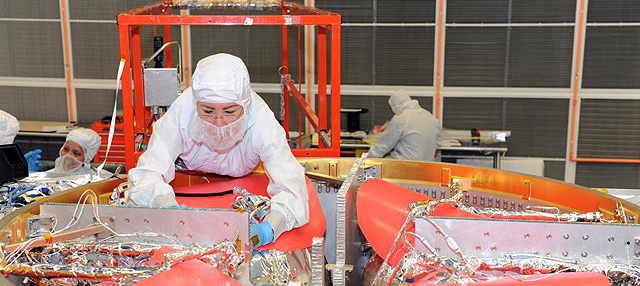Connections And Reconnections, Linked By Plasma Physics

A technician works on a propulsion module for the Magnetospheric Multiscale mission.
NASA
This is a guest post from physics Ph.D. student Jason Shuster.
Sometimes, as a new Ph.D. student in plasma physics at the University of New Hampshire, I get strange looks when referring to the everyday concepts in our field such as Lorentz force, quasineutrality, and the ExB drift. Perhaps some people think that these concepts have little to do with the everyday, down-to-earth struggles and challenges that our country is facing… but this view is a misconception.
I began studying a fundamental plasma process called "magnetic reconnection" in 2010, as a research assistant under Li-Jen Chen at UNH's Space Science Center. My research in space physics fulfills a childhood dream. I am even scheduled to participate in a NASA mission expected to launch in 2014, called Magnetospheric Multiscale.
Simply put, plasmas are electrically charged gases. Plasma is, in fact, the most ubiquitous state of matter in our universe: stars are essentially spheres of plasma. Plasmas exist on Earth naturally as lightning discharges, and we use plasmas to power fluorescent light bulbs and neon street signs. The dynamics and motions of plasmas are widely discussed and debated in Earth and space science circles, including in December at the American Geophysical Union’s fall meeting, hosted in San Francisco.
The study of the complex plasma environment comprising the Sun’s magnetic field and our own Earth’s magnetic field directly influences our everyday lives. Working to better understand plasma physics aids in improving the predictive capability of space weather observations. This in turn brings us one step closer to predicting when the Sun’s occasionally massive outbursts of charged particles and magnetic energy – known as coronal mass ejections – will strike Earth’s magnetic field. Such an event could ignite beautiful displays of the auroras (Northern and Southern lights), send a surge through power grids that knocks out electrical transformers or threaten the lives of astronauts and communication satellites such as the ones enabling our trusted GPS devices.
For these reasons, I hold that plasma physics is a very "down-to-earth" science.
In San Francisco this December, I had the opportunity to present my work concerning what are called particle-in-cell simulations of magnetic reconnection, a fundamental plasma process which converts stored magnetic energy, often explosively, into particle kinetic energy and heat. Magnetic reconnection is described by a NASA article as "the universe’s favorite way to make things explode."
While I study magnetic reconnection in the context of Earth’s magnetosphere, reconnection is also important for laboratory fusion experiments, in such devices as the tokamak and stellarator, where strong magnetic fields are used as the means for confining plasma in hopes of discovering how to effectively produce power from thermonuclear fusion.
Of course, conferences are also great opportunities to reconnect with colleagues. The 5-day meeting in December featured thousands of research presentations each day -- as over 20,000 space, ocean, and Earth scientists moved around the hall, somewhat resembling a plasma ourselves.
